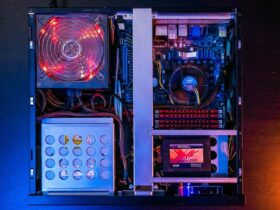The Graphics Processing Unit (GPU) is the beating heart of modern computing, powering everything from gaming rigs to data centers. Its remarkable computational prowess generates substantial heat, necessitating efficient cooling solutions. Among these solutions, the operation of GPU fans has been debated among PC enthusiasts and users. Should GPU fans always be on, or is there merit in allowing them to adapt to varying workloads? In this article, we delve into the pros and cons of different GPU fan operation modes, explore the factors that influence their performance, and offer practical insights to help you make an informed decision about managing your GPU’s cooling system effectively.
Should GPU Fans Always Be On?
Whether GPU fans should always be on depends on several factors. Generally, modern GPUs are designed to manage their fan speeds automatically based on temperature and workload. Keeping fans on constantly may provide consistent cooling but can increase power consumption and noise. On the other hand, allowing adaptive fan control can save energy and reduce noise during idle or light tasks. Still, it may result in occasional temperature spikes during heavy gaming or rendering. It’s essential to consider your specific usage, GPU model, and noise tolerance when deciding whether to keep GPU fans always on or use adaptive settings.
The Importance Of GPU Cooling
GPU cooling is paramount for the proper functioning and longevity of a graphics processing unit (GPU). GPUs are designed to handle heavy computational workloads, such as gaming, video rendering, and machine learning tasks. As they process data, GPUs generate a significant amount of heat, which can have several critical implications:
Temperature Regulation and GPU Health:
GPUs are designed to operate within specific temperature ranges. If these limits are exceeded, it can lead to many issues, including hardware failures and crashes. Overheating is a common cause of GPU damage, and the consequences can be expensive. Proper cooling systems are designed to keep the GPU’s temperature within safe bounds, preventing it from overheating and thus preserving its functionality.
Performance Optimization:
GPUs are known for their parallel processing capabilities, making them ideal for tasks that require substantial computational power. However, they perform at their best when operating at optimal temperatures. Inadequate cooling can lead to thermal throttling, where the GPU automatically reduces its clock speeds to prevent overheating. This results in diminished performance and potentially an unsatisfactory user experience.
Stability and Reliability:
Overheating not only affects performance but can also lead to system instability. When a GPU runs too hot, it may cause your entire computer to freeze, reboot, or shut down unexpectedly. This not only disrupts your workflow but can also result in data loss or corrupted files.
Lifespan Extension:
Continuous exposure to high temperatures can significantly shorten a GPU’s lifespan. Effective cooling solutions dissipate heat efficiently, helping to prolong the life of your GPU. This, in turn, reduces the need for frequent and costly GPU replacements or upgrades.
Noise Reduction and User Comfort:
Cooling systems often involve fans or other cooling mechanisms. While essential for temperature control, these fans can produce noise, which can be bothersome in quieter computing environments. High-quality solutions balance efficient cooling and noise reduction, ensuring a comfortable and enjoyable computing experience.
GPU Fan Operation Modes
GPU fan operation modes play a pivotal role in maintaining the temperature and performance of a graphics processing unit (GPU). These modes determine how the GPU’s cooling fans behave, balancing cooling efficiency and noise generation. There are generally three primary GPU fan operation modes:
In this mode, GPU fans run constantly at a predefined speed, regardless of the GPU’s workload or temperature. Continuous operation ensures a consistent level of cooling but can be less energy-efficient and noisier, as the fans are always running, even during idle or light tasks. This mode is often seen in older GPUs or entry-level graphics cards.
Adaptive fan operation is a more modern and common approach. In this mode, the GPU’s fans adjust their speed dynamically based on the GPU’s workload and temperature. During idle or light tasks, the fans may run at lower speeds or even stop altogether, reducing noise and power consumption. When the GPU is under heavy load, such as during gaming or rendering, the fans spin up to maintain a safe operating temperature. This mode strikes a balance between cooling efficiency and noise reduction.
Some GPUs and software utilities allow users to control the fan speed manually. Users can customize the fan speed to their preference, balancing cooling performance and noise levels. Manual control is handy for advanced users who want to fine-tune their GPU’s cooling for specific tasks or noise tolerance. However, it requires vigilant monitoring and adjustment, as setting the fan speed too low may lead to overheating while setting it too high can result in unnecessary noise.
Pros And Cons Of Keeping GPU Fans Always On
Keeping GPU fans always on is a topic of discussion among PC enthusiasts and users who want to strike a balance between cooling efficiency and noise levels. Here are the pros and cons of this approach:
Pros of Keeping GPU Fans Always On:
- One of the primary advantages of keeping GPU fans always on is that it ensures a consistent level of cooling. The GPU remains stable regardless of the workload or ambient temperature. This can be particularly important when maintaining low temperatures is critical, such as in high-performance gaming rigs or professional workstations.
- A more excellent GPU generally experiences less wear and tear over time. By keeping the fans always on, you can extend the lifespan of your GPU, as it operates within a safe temperature range. This may save you from having to replace or upgrade your GPU prematurely.
- Continuous fan operation can help prevent dust accumulation inside the GPU and its cooling components. Dust can impede airflow and insulate the GPU, leading to increased temperatures. Keeping the fans running helps mitigate this issue.
Cons of Keeping GPU Fans Always On:
- The primary drawback of keeping GPU fans always on is the increased power consumption. The fans consume electrical energy continuously, which can lead to higher electricity bills over time. In situations where energy efficiency is a concern, there may be better approaches.
- Constant fan operation inevitably leads to noise generation. The fans can be audible, especially if they run at high speeds. For users who value a quiet computing environment, the persistent noise can be bothersome and distracting, particularly during idle or light workloads.
- Continuous fan operation may increase wear and tear on the fan components, including the bearings and motor. Over time, this can lead to fan degradation or failure, requiring fan replacement. This is less of a concern with high-quality fans but is still worth considering.
Practical Tips For GPU Fan Management
Effective GPU fan management is essential for maintaining optimal performance and longevity of your graphics processing unit. Here are some practical tips to help you manage GPU fans effectively:
Update Graphics Drivers: Ensure your GPU drivers are up-to-date. Manufacturers often release driver updates that include optimizations for fan control and temperature management.
Enable Adaptive Fan Control: Most modern GPUs have adaptive fan control as the default setting. This allows the fans to adjust their speed based on workload and temperature. Keep this setting enabled for a balance between cooling efficiency and noise reduction.
Monitor GPU Temperature: Use monitoring software to monitor your GPU’s temperature. Popular tools like MSI Afterburner, HWMonitor, or GPU-Z provide real-time temperature readings. Knowing your GPU’s temperature helps you assess whether the cooling system works effectively.
Clean Your GPU: Dust buildup can reduce the effectiveness of your GPU’s cooling system. Periodically open your computer case and carefully clean the GPU and its fans using compressed air or a can of compressed air. Ensure your PC is powered off and unplugged when doing this.
Ensure Proper Airflow: Good case airflow is essential for GPU cooling. Make sure your computer case has adequate ventilation and that there are no obstructions near the GPU’s intake and exhaust areas. Proper cable management can also help optimize airflow.
Custom Fan Curves: Some GPU management software allows you to customize fan curves. This means you can set specific fan speeds for different temperature thresholds. Adjusting the fan curve can help balance cooling performance and noise levels according to your preferences.
Regularly Replace Thermal Paste: Over time, thermal paste between the GPU chip and heatsink can degrade, reducing heat transfer efficiency. Consider replacing the thermal paste every few years to ensure optimal cooling.
Use Aftermarket Cooling Solutions: Depending on your GPU model and usage, you may benefit from aftermarket cooling solutions. These can include larger heatsinks, additional fans, or even liquid cooling systems designed specifically for GPUs. Be sure to check compatibility with your GPU before making upgrades.
Conclusion
GPU fan management is a critical aspect of maintaining the performance, longevity, and overall functionality of your graphics processing unit. Properly managing GPU fans involves finding the right balance between cooling efficiency and noise levels to suit your specific needs and preferences. Whether you choose to keep GPU fans always on, use adaptive fan control, or manually customize fan settings, it’s essential to consider factors such as your GPU model, usage patterns, and tolerance for noise. Each fan management mode has its pros and cons, and the optimal choice will vary from person to person.
FAQ’s
Q: What is the ideal temperature range for my GPU?
A: The ideal temperature range for a GPU typically falls between 60°C to 85°C (140°F to 185°F) under load. However, it can vary depending on the specific GPU model. It’s crucial to consult your GPU manufacturer’s documentation or website for recommended temperature ranges.
Q: How do I monitor my GPU temperature?
A: You can monitor your GPU temperature using software tools such as MSI Afterburner, HWMonitor, GPU-Z, or your GPU manufacturer’s monitoring software. These tools provide real-time temperature readings.
Q: Should I keep my GPU fans running at full speed all the time for better cooling?
A: Keeping GPU fans at full speed all the time can provide efficient cooling but may result in excessive noise and increased power consumption. It’s generally recommended to use adaptive fan control settings to balance cooling and noise, especially during idle or light workloads.























Leave a Reply